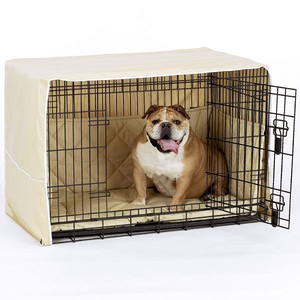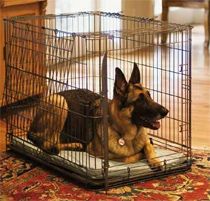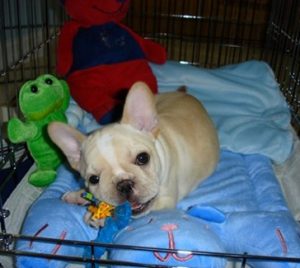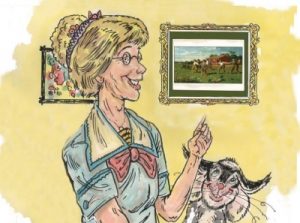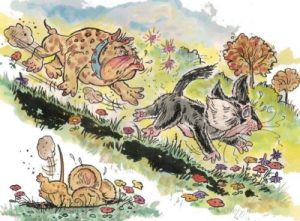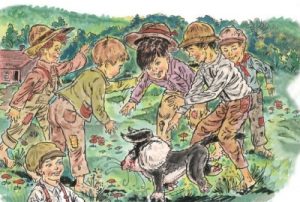
Male Tiger Swallowtail.
Every year at this time, my class (along with undoubtedly thousands of other classrooms in the US) purchases a cup of caterpillars to raise and release. We do this to show the children the process of metamorphosis, but did you know that you don’t have to rely on a teacher to raise your own butterflies?
There are two ways that you can participate in this wondrous part of the natural world. First, you could buy a kit like I did or you could find your own caterpillars and raise them. Taking care of caterpillars and butterflies isn’t really that hard and releasing them into your garden is a rewarding feeling. This is especially true when you see a butterfly of the same species later and wonder, “Is that one of mine?”
I want to say here that I don’t typically agree with taking a wild animal and bringing it into the home unless it is absolutely necessary. In my opinion, forcing wild animals to become tame in any way should be discouraged since they need their natural instincts to survive and our interactions with them remove some of that instinct. It is a slightly different story with insects, however, because they are easily kept without much handling and you are increasing their numbers when you release them into the wild. If you have found a caterpillar or eggs on a plant from the garden, it is better to raise them and release them than spray the plants with pesticides that will kill them before they have a chance to mature. By taking them away from your garden and feeding them from the species specific plants that you purchased, you are saving the butterflies and saving your garden. In my case, I would rather save the caterpillar than have it be squashed by an eager child’s fingers in their excitement to pick it up and show it to me. Why not save that one caterpillar and help it on its way once it grows up?
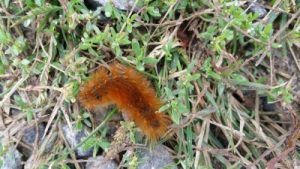
What is possibly a Lined Ruby Tiger Moth caterpillar, found on a mountain trail.
Butterfly Supplies
Before you rush out to raise butterflies, you need to give some serious thought to how you are going to contain them. The old insect in a jar image comes to mind, but this is highly inappropriate, uncomfortable, and unhealthy for any creature you catch, especially butterflies. A caterpillar may not need too much room, but when it matures, it will have a wingspan that requires more space than your jar can provide.
Most classrooms and science museums get their butterfly supplies from Insect Lore. This is a wonderful site that offers all types of educational tools as well as live insects to raise and release. They have kits available for Painted Lady butterflies, ladybugs, ants, and praying mantes. (Yes, that’s the plural for praying mantis, and if you have never watched them hatch out of their case, it is really something to see!) I have both their “butterfly garden” and “butterfly pavilion” pop up nets and I must say that I prefer the pavilion when it comes to the health of the butterflies and also for the purposes of viewing. The “garden” is a small size, about a foot tall and doesn’t give your butterflies much room to fly around, especially if you intend to reuse this with other, larger types of butterflies found around your home. The “pavilion” is about two feet tall and allows room for you to decorate their habitat in a more natural way while leaving them plenty of space to fly. I also find that most people enjoy butterflies more when they are in a larger habitat. Both of these have a handle that allows for hanging from the ceiling or other location, but if you put a potted plant inside, please do NOT hang your habitat! The habitat is not stable or sturdy enough to hang with any weighted object inside and this could also harm your butterflies if the plant falls over.
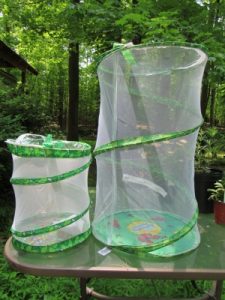
Butterfly habitats from Insect Lore, The “butterfly garden” is on the left and the “butterfly pavilion” is on the right.
You don’t have to buy from Insect Lore, however. The Educational Science online nature store has a wide variety of habitats to choose from, including an abundance of live kits, outdoor tents, specialty equipment, and host plants. This was a site I discovered while searching for caterpillar rearing supplies and though I have not yet placed an order, I fully intend to. Their variety has simply made my heart sing, especially since they offer a range of larger tents and enclosures for raising happier, healthier butterflies. For someone who intends to raise local caterpillars, this is an important factor, because a butterfly requires at LEAST twice the space of their wingspan when they emerge from their cocoon. That measurement is three dimensional, in every direction. If you find a Luna moth, you are looking at a nearly five inch wing span, so you will need ten inches all around. Once your moth or butterfly starts to fly, they are certainly happier with more room to do it in. You might want to consider something even larger than that if you are going to keep them for any length of time before you release them. Whatever habitat you choose, once it is in your possession you can begin your quest for caterpillars.

This female Swallowtail Butterfly was hit by a car in the parking lot of Eno River State Park in North Carolina and did not survive.
Caterpillars By Mail
One of the two ways to raise butterflies is to get a kit by mail. Both Insect Lore and the Educational Science store offer live kits, where caterpillars are shipped to you. Insect Lore guarantees that three out of five butterflies will grow to maturity, while Educational Science guarantees only that the caterpillars shipped to you will be alive when they get there. In nature not every butterfly survives to maturity and there is not really any way to avoid this in captivity either. It is just how the world works. I will say that in all of my years of raising butterflies, I have only had to report one unsuccessful maturing of butterflies to Insect Lore and have never lost a “wild” caterpillar that my children found. Butterfly rearing may be simple enough, but it is precise, and if you do it by the book, you should have very good results.
Be aware, you may also have a mature butterfly emerge with an unusual deformity. My class once raised a Painted Lady whose wings came in backward on the right side. The top wing was where the bottom wing should have been, and vice versa. We named this butterfly Wilbur and kept it for its entire life span because it could not fly and releasing it into the wild would have been sending it to a cruel life where it could not get to any food or protect itself. Keeping Wilbur was an amazing opportunity for the children to interact with a butterfly up close without worry of it getting away. “He” wandered our classroom, walking around from surface to surface, “shared” our lunches and was basically the puppy of butterflies; so, not all mishaps with shipped larvae are tragic experiences.
When you place an order for caterpillars from any store, check the delivery date CAREFULLY. Someone MUST be in the delivery location to receive the caterpillars in order to place them indoors, in climate controlled conditions. Caterpillars are typically shipped in plastic cups or containers, which are put in a shipping box and mailed to you. Imagine being put in a hamster ball, then dropped into a cardboard box, and finally left in a metal or plastic mailbox while the hot sun beats down on you. This is what your caterpillars will endure if they are left alone on shipping. I can’t emphasize enough how important it is to arrange delivery at a time when you can care for them right away.

Example of cups sent from Insect Lore, each containing five larvae.
Please note: My current experience of raising butterflies by mail is only with Insect Lore, so from this point onward my description of shipped larvae rearing is based solely on that knowledge.
Once you have your caterpillars, set the cup in a safe location, away from air vents and direct sunlight. Your caterpillars should come with care instructions that I highly recommend you follow if you are a novice. There are those who order cups and remove the caterpillars into a habitat that provides fresh food rather than the processed food that comes in the cup with them. I however, do not recommend this unless you have expert experience in handling butterflies. There are parasites and other issues to worry about when raising caterpillars and the cup that they are in is a secure environment that protects them from that without any hassle to you, their caregiver. Once they have all made their cocoons, you may open the lid and transfer them to your butterfly habitat in the way described in your kit’s instructions.
When I place my cocoons from the cup into the habitat, I generally do not include the butterfly’s host plant, but leave the structure open and free of anything that could harm the butterflies while they are emerging. It is only once all of the butterflies have emerged and their wings are dry and ready to use that I introduce the host plant and a food source to their environment. If you have one butterfly that emerges well before the others and you are worried that they will be waiting a long time for food, you can introduce it, but keep a careful eye that the emerging butterflies do not become stuck or trapped in the food source while their wings are drying.
NEVER touch a butterfly when it is emerging from the cocoon or for three hours afterward. Remove the empty cocoons only when the last butterfly has had two or three hours to dry its wings. Once all of your butterflies have emerged, you can release them, or introduce a host plant in hopes that they will breed. More on that later.

Painted Lady butterfly sitting on one of their host plants, a Hollyhock.
Caterpillars From Home
The most important thing about raising a caterpillar that you found somewhere around your home is identifying what type of caterpillar you have and providing it with the proper food. If you find an egg on a leaf, it is a fairly safe bet that the mother butterfly laid it there because this is the host plant and you already have the proper diet displayed for you. Now, simply grab more leaves from whatever plant you found the egg on and place them in your habitat. (Or get one of the special bags or nets to put over the plant that will contain the caterpillars, but allow the plant to grow.) If you find a live caterpillar, always identify it and research what types of food it needs. That caterpillar could be traveling from one plant to another and the leaf or branch it is on does not necessarily represent the type of food it eats.
When it comes to identifying anything for our classroom, I use the website Discover Life. I prefer this site, because it uses images and selective sorting to help narrow down your search. Just click the “ID Nature Guides” link at the top, find the creature or plant that you are searching for, and you are on your way to identification. For caterpillars, you can select main body color, main body pattern, hair density, and distinct features. Sometimes your caterpillar is hard to find, but don’t give up the search. If you reach a point where you simply can’t identify what you have, ask a specialist or go out to where you found the caterpillar and grab one of every leaf and blade of grass that you can find, then place them all in the habitat as an offering. Take note of what the caterpillar eats and provide more of that food, removing the rest.

A Luna moth caterpillar, identified using the Discover Life website and the Butterflies and Moths of North America site: Butterflies and moths
You need to research your caterpillar carefully. Not only do you have to give it the right kind of food, but you also need to understand how it will create its chrysalis. We are all familiar with butterflies who hang upside down and scrunch their bodies into tight, hard cases. However, some caterpillars will instead glue a leaf around themselves which acts as a cocoon. If you assume which type of caterpillar you have incorrectly, you may check on it one day to discover that it has made the best of a bad situation and wrapped itself in whatever it can find, which usually means it will not survive. If you choose to take a caterpillar from the wild, always research it thoroughly, not only in the larvae stage, but in the butterfly stage as well. You need to be certain that you are providing it with the proper materials for metamorphosis, but also the right diet and living space throughout its entire life span. If you want to make it more comfortable in its habitat, you can also research the butterfly’s host plant and provide that as a comfort object, which will reduce the stress your butterfly feels being completely exposed in an empty net. The host plant will also help you, if you decide to try and breed your butterflies.
What to Feed Them
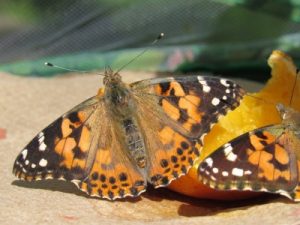
A Painted Lady, spreading its wings to enjoy the warm sun and preparing to eat.
It is fairly easy to feed your butterflies, no matter where they come from or what type they are. You may start by:
- Making a sugar water mixture that is one part sugar to four parts boiling water (or follow the instructions in your kit) and place a bright sponge into a dish of this mixture. Change daily.
- Providing cut oranges, grapefruit, peaches or strawberries. If your butterflies do not eat one type of this, try another type. Remember to cut fresh fruits daily.
- Using butterfly feeders available online for purchase that will most likely come with a recipe of their own.
- Remember: Butterflies eat more when they feel content and warm. To encourage your butterflies to eat and to give them a happier existence overall, take your habitat outside for a few hours, so they can enjoy the sun and fresh air
Time For Babies
Once you know the host plant of your butterfly, you can add that to the habitat when they have emerged and their wings are dry, but the biggest part of breeding is obviously having at least one male and one female. Some butterflies (like the Easter Tiger Swallowtail) are easy to identify, but others (such as the Painted Lady) aren’t as simple. The only way to know what you have is to research them. Find pictures, compare, ask an expert, or just keep your butterflies together for a day or two and see how they react to each other. If you find two butterflies back to back, seeming to be glued together at the tail end, you have a male and a female.

The white-green dots on this Hollyhock leaf are the tiny eggs laid by a Painted Lady butterfly.
Most butterflies don’t take too long to mate and lay eggs, so within a day or two they should pair off and within another day or two they should start looking for a place to lay their eggs. Again, I have only witnessed this process with Painted Lady butterflies, so I am now describing their behavior.
When a female is ready to lay her eggs, she wanders around a leaf, seeming to frantically rub it with her front legs. This is how she “tastes” the leaf to be certain it is the right kind for her children to eat. Once you start to see this shift in behavior, pay close attention to where she is in your habitat and take note of where she is putting the eggs, so that you can keep an eye on them.
Keep in mind, breeding butterflies is NOT easy. First of all, butterflies do not inbreed well, so the chances of the eggs maturing and providing you with happy, healthy caterpillars are smaller if you have gotten your original batch from the same source. This could be an online catalog or from the same location in your neighborhood. Secondly, there are parasites that can harm your caterpillars, which is why customers are asked not to open containers of caterpillars to re-home them on their arrival. Finally, it can just be too darn hard to contain them. I have only managed to breed our Painted Ladies three times in the many years that I have been ordering them. Once, we had so many eggs that hatched we were looking at housing an uncountable number of caterpillars… until they all escaped their enclosure. I have never successfully raised one to full size, however that doesn’t stop me from letting them lay an egg or two for the children to see before I let the butterflies go to find more suitable arrangements for their future offspring. There are habitats that you can purchase that are more suitable for raising freshly hatched caterpillars and I would highly recommend talking to an expert if you decide you would like to give your little ones the best chance for survival in captivity.

Painted Lady caterpillars one day after hatching. These are barely the size of a dot made by a ballpoint pen.
Raising butterflies is a rewarding and wonderful experience for young and old alike. With the age of the internet, it is easier than ever to provide a suitable habitat to ensure that the species you find will be as happy and healthy as possible while you watch them grow, mature, and change. If you handle your butterflies as little as possible and always use host plants that have not been treated with pesticides, you are giving your new friends a great start. Watching the metamorphosis of these beautiful creatures is both exciting and rewarding and I wish you success in your new adventures together.
 Mirrani Houpe, our Small Animal Editor, has had rats since she took home her first little boy once they both completed the second grade. Since that time she has owned, rescued and bred many kinds of rats, from many backgrounds. She may not be a vet, psychology major, or scientist, but her babies have her very well trained when it comes to how to care for them. She is constantly working with her family’s veterinarian to come up with new and innovative ways to love and care for the most often misunderstood rodent in the pet world. You can e-mail her at mirrani@yourpetspace.info
Mirrani Houpe, our Small Animal Editor, has had rats since she took home her first little boy once they both completed the second grade. Since that time she has owned, rescued and bred many kinds of rats, from many backgrounds. She may not be a vet, psychology major, or scientist, but her babies have her very well trained when it comes to how to care for them. She is constantly working with her family’s veterinarian to come up with new and innovative ways to love and care for the most often misunderstood rodent in the pet world. You can e-mail her at mirrani@yourpetspace.info
